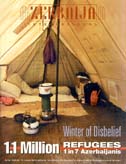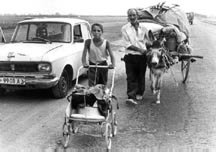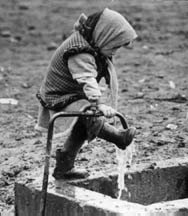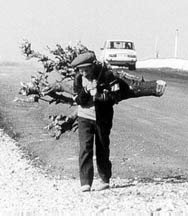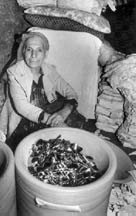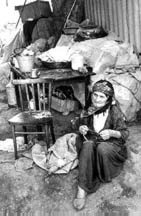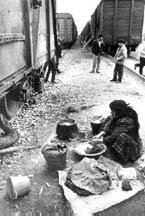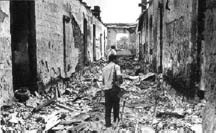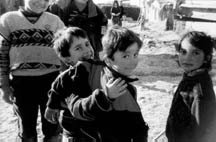Spring
1997 (5.1) Editorial by Betty
Blair
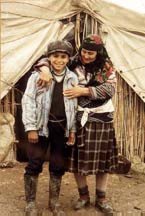 But after the Soviet collapse in late 1991, Armenians began systematically expelling Azerbaijanis from the enclave of Karabakh - despite the fact that this territory belonged to Azerbaijan and was significantly populated with Azerbaijanis who had been living there for centuries. It's true that the majority of the population was Armenian when trouble started brewing in Karabakh. Many of them are descended from settlers that Russia brought to Karabakh from regions outside of the Caucasus in the first half of the 19th century. By late 1992
and early 1993, Karabakh was flushed of all Azerbaijanis - known
in the media as "ethnic cleansing." Those who did not
leave were either killed or taken as hostages (some of whom have
yet to be released).
Photos: Oleg Litvin Then the Armenian military pushed beyond to regions outside Karabakh - allegedly to create a "buffer zone" for themselves but more likely to deal a stronger hand at the bargaining table. They did not stop until they had seized 20 percent of Azerbaijan's territory and displaced hundreds of thousands of more people. A tenuous cease-fire was signed in May 1994. But Azerbaijan wants its land back and its people returned to their homes. One out of every seven Azerbaijanis are refugees. It boggles the
mind to think what chaos would result in our own countries if
nearly one out of every seven individuals were to be totally
stripped from their sources of income, their land and everything
they possessed. Even in countries with highly sophisticated infrastructures,
human services would be hard pressed under such circumstances.
Photos: Left: by Elnur Babayev. Right, by Betty Blair How much more difficult it is for a fledgling country like Azerbaijan, struggling to shed a centralized Soviet system and adopt a market economy, to deal with this crisis. Skeptics will counter that Azerbaijan is potentially one of the richest countries in the world and that they should be able to handle this disaster without international assistance. But the oil has not yet begun flowing to foreign markets, and the survival of nearly 1 million people cannot wait until then. Despite the enormity of Azerbaijan's refugee problem, the world knows relatively little about it. That's why we've decided to focus on this topic for the second time [see AI 2.1, January 1994, "Winter of Disbelief" on the Web]. This is our fifth year of publication, and we have never repeated a theme. But this subject just doesn't go away. Usually, we focus on the positive efforts that are being put forth to strengthen Azerbaijan, but the tremendous amount of human suffering that is going on cannot be overlooked. Not a Religious Conflict
Photos: Oleg Litvin "Life in Azerbaijani Refugeee camps" These words, seemingly so innocuous, serve Armenians well. True, they do represent the traditional tendencies of both countries. Yet, given their Soviet heritage, both countries are actually quite secular in practice when it comes to commitments of belief and faith - Azerbaijanis being more secular than Armenians. However, the underlying implication suggests that the war stems from deep-seated ideological differences. For many Westerners in search of simplistic explanations, no other discussion is necessary; they already know who the "bad guys" are. Few care to probe deeper to ascertain the truth. Azerbaijanis would argue that religious or ethnic differences are not central to the conflict at all. Instead, they see the war as a calculated act of aggression by Armenians simply to annex Azerbaijan's territory (Nagorno-Karabakh). Land Grab
Left: Armenian attack on an Azerbaijani school. Photo: Oleg Litvin Right: Best of friends, Azerbaijani boys
in Refugee camp run by Turkish community. Economic Development
Important for all the Caucasus
Azerbaijanis fleeing Kelbajar, 1993 Everyday realities - when the tents ran out, refugees made shelters of reeds. Photo: Oleg Litvin. Often, the international community views religious conflicts as too complex to resolve from the outside. Perhaps unconsciously, the assumption is made that the warring parties should be left to stew in the mess they've created for themselves because nobody else can really bail them out anyway. Despite such attitudes, international humanitarian agencies are aware of the true situation and have tirelessly sacrificed to help Azerbaijan through this crisis despite limited resources and personnel. Their work has made an incredible difference. Many refugees owe their lives to this generosity, and Azerbaijan authorities are among the first to admit their tremendous contributions [see Relief Agencies, page 74]. In preparation for this issue of our magazine, I recently spent time living in the camps with the refugees. There's hardly a single Azerbaijani who doesn't desperately want to go back to his homeland. People talk about it all the time. They'll tell you, "All we want is to go back and find the tree that we used to sit under. These are the worst years of our lives." Or "If only I could go back and stand out on my balcony, I could die the next day." But realistically, returning home will not happen any time soon for the majority of the refugees. Those heavily involved in the relief process believe that even if a peace agreement were signed tomorrow, it would take five years or more before most could be resettled. The conflict region is thickly seeded with land mines which must be cleared - a very dangerous and exorbitantly expensive process. Then, reconstruction must take place as most homes have been completely destroyed. But still, most Azerbaijani refugees are convinced that their wish to return home is not a fantasy and that it will happen eventually - with the help of God and Aliyev. Zbigniew Brzezinski, former head of the U.S. National Security Council under President Carter, visited some of the camps in Azerbaijan in 1995. He observed that the conditions there were "inhumane" - even worse than what he had seen in either Afghanistan or Palestine. Year after Year The low marshlands on which many of the camps are built are swollen with mosquitoes in summer. Last year, hundreds of cases of malaria were reported. This year, there's likely to be more. Food rations have diminished after four years of living in the camps. These days, too many meals consist only of bread and tea. Some families are too poor even to buy kerosene needed to cook their food and are left to wander in search of dried sheep dung to burn as fuel. Lack of Education Tragically, the children are falling through the cracks. It's one of the most serious problems that Azerbaijan faces. This nation, in its effort to become an independent country, cannot afford to lose this young generation by allowing refugee children to become marginalized. Every effort must be made to incorporate them into the mainstream community. To facilitate this process, it is important that the Azerbaijan government give serious thought to dismantling the larger camps. Problems are so overwhelmingly difficult that residents living there can barely manage to deal with their own personal needs, much less work for the betterment of the group. Such camps also serve as breeding grounds for the discontented and for foreign fundamentalist movements. They are potential bomb shells that will likely flare up in political and social unrest if people are not relocated into smaller, more manageable and more self-reliant, self-sustaining communities. And the sooner, the better. To this end, some humanitarian agencies are beginning to relocate some of the most vulnerable groups of refugees to significantly smaller settlements that are just now being constructed. And in the process, possibilities are opening up to build limestone block schools and community centers as these new settlements are being developed and the construction crews are still on site. But funds are desperately needed to accomplish these "frills," or it won't happen. For only $2,000, donors can "Adopt a School" through Relief International and UNHCR and even have their name put on it. This is only one of the many creative ways possible for private individuals, cultural societies and businesses to get involved. The Azeri word for refugee is "gachgin," meaning "runner." The term implies that there is no rest for them - no security, no refuge from the pain. We all need to work tirelessly to make this tragic period pass as quickly as possible so that these "runners" can soon be relieved of their agony and misery - especially the children. The term, "refugee" needs to be perceived as a transitional period, not a situation in which they will have to spend the rest of their lives. From Azerbaijan International (5.1) Spring 1997. Back to Index
AI 5.1 (Spring 1997) |

